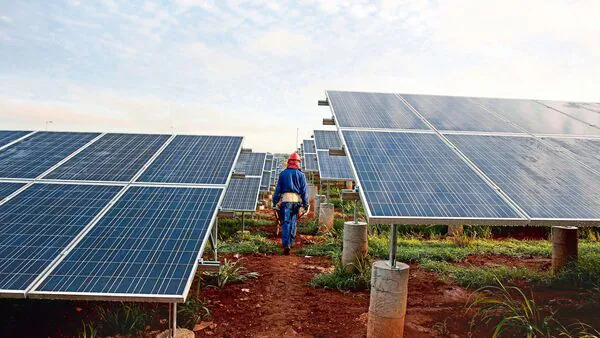India Plans New Incentive Scheme To Power Local Solar Manufacturing
New Delhi: The government is working on a new incentive scheme to boost production of wafers and ingots, key sub-components that go into making solar photovoltaic (PV) modules, amid choked supplies from China, three people with knowledge of the matter said.
The Union ministry of new and renewable energy (MNRE) is likely to spend an unused sum of around ₹5,500 crore from an existing incentive scheme for solar module manufacturing, to boost production of these key inputs, they added, requesting anonymity.
In April 2021, the Union cabinet approved the production-linked incentive (PLI) scheme for National Programme on High Efficiency Solar PV Modules under the ministry of new & renewable energy with an outlay of ₹4,500 crore. Subsequently, the government approved a second tranche of the PLI scheme in September 2022 with an outlay of ₹19,500 crore, of which about ₹13,937 crore has already been allocated. The remainder ₹5,563 crore is likely to be diverted for a new incentive scheme to boost production of wafers and ingots.
In the solar module supply chain, polysilicon is the initial raw material, which is used to produce ingot, which then is developed into wafer, followed by cells before a solar photovoltaic module is finally assembled.
Also Read | Govt may let developers exit stalled renewable projects without penaltie"The proposal from MNRE is that there already is unutilized fund under the PLI scheme which can be utilized specifically for wafers and ingots. The scheme is being finalized," the first of the three persons cited earlier said.
The modalities of the proposed scheme are being worked out, and are expected to be different from the ongoing PLI scheme.
Under the PLI for solar modules, the manufacturing units sanctioned under the scheme are eligible for getting the incentives annually for five years from commissioning the capacity, on the basis of the sales of high-efficiency solar PV (photo-voltaic) modules each year.
Slow pace of implementationThe consideration for a change in modalities of the incentive scheme comes amid a slow pace of project implementation in the ongoing PLI. In June, Mint reported that the government is considering extending the deadline for completion of projects under the PLI scheme amid delays in technology sourcing and component supply from China.
A second person noted that government is also likely to announce extension of the deadlines under the ongoing scheme by one year to FY27. The scheduled commissioning dates for projects under the second tranche range from October 2024 to April 2026.
Also Read | Sun stroke for solar projects, change in rule traps developerQueries sent to the union ministry for new and renewable energy remained unanswered till press time.
Earlier this month, new and renewable energy minister Pralhad Joshi highlighted plans to develop a fully-indigenous solar value chain, targeting domestic solar cell manufacturing with local components by 2028. He also emphasized the government's focus on supporting wafer and ingot production in the country.
"The country is now advancing beyond modules to develop domestic capacity for wafers and ingots as well, ensuring that the entire solar manufacturing ecosystem is established within India. This will not only reduce import dependence but also generate employment, boost investment, and strengthen India's position as a global leader in clean energy manufacturing," Joshi had said. So far, about ₹50,000 crore has been invested in the country's solar equipment manufacturing sector.
Amid supply chain concerns and need for local capacity, India has developed about 100 GW of solar module capacity and about 27 GW of cell manufacturing capacity. However, the capacity for producing wafers and ingots is just around 2 GW, with the country relying completely on Chinese imports.
According to a report by CareEdge, the recent volatility in input prices, driven by supply-chain shifts in China, strengthens the case for setting up wafer and ingot capacity in the country.
The ministry has already proposed to come up with an Approved List for Models and Manufacturers (ALMM) for wafers from June 2028. If the plan takes a concrete shape, all solar modules used in government-backed projects will have to use locally-made wafers and ingots. Currently, the norm is applicable for modules. The rules will apply to cells with effect from June next year.
Also Read | MNRE may propose tax incentives for green bond buyer Legal Disclaimer:
MENAFN provides the
information “as is” without warranty of any kind. We do not accept
any responsibility or liability for the accuracy, content, images,
videos, licenses, completeness, legality, or reliability of the information
contained in this article. If you have any complaints or copyright
issues related to this article, kindly contact the provider above.
Most popular stories
Market Research

- New Cryptocurrency Mutuum Finance (MUTM) Raises $15.8M As Phase 6 Reaches 40%
- Bydfi Joins Korea Blockchain Week 2025 (KBW2025): Deepening Web3 Engagement
- Yield Basis Nears Mainnet Launch As Curve DAO Votes On Crvusd Proposal
- 0G Labs Launches Aristotle Mainnet With Largest Day-One Ecosystem For Decentralized AI
- Ethereum-Based Defi Crypto Mutuum Finance (MUTM) Raises Over $16 Million With More Than 720M Tokens Sold
- Fintech's Gender Gap In Focus: Drofa Comms' Women Leading The Way Joins Evolvh3r's She Connects At TOKEN2049






















Comments
No comment